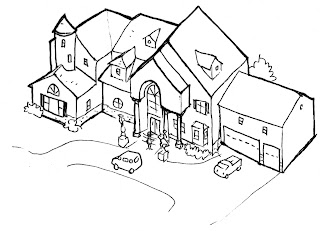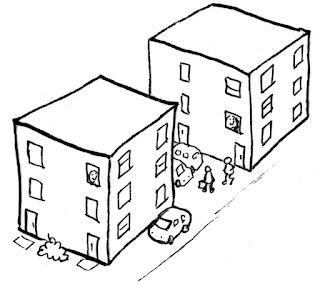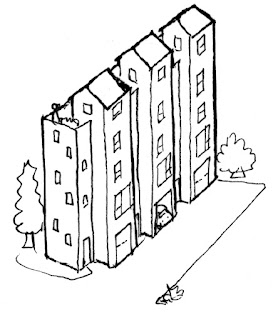McMansion
Time Period: 1980s to present
Location: Suburbs, exurbs, and rural areas nationwide
Mass produced mansions for super-sized American dreams
Key features
- Over 3,000 square feet with 4 or more bedrooms
- Designed to impress: double height entrances and other decorative features on front of house
- 2+ car garage
While houses have always been a way people show off wealth, and owning a house has been central to the American Dream since the beginning of this country, several factors came together in the 1980s to create the McMansion. Clothing, which had traditionally been a primary way of showing off wealth, was becoming less important, outside of a handful of places such as New York City. Casual fashion had gone mainstream, and a drop in clothing costs relative to income meant that even the middle class could afford fancy clothes if they wanted. Homes, though, were still expensive enough to remain a status symbol.
Another factor was the 1986 Tax Reform Act, a Reagan-era tax cut for the rich which also made tax policy changes that made investing in apartment buildings less attractive. The mortgage interest deduction for owner-occupied homes remained untouched. The top income tax rate went down from 50% to 33%. The rich now had more to spend, but instead of investing in apartments, they were now encouraged to borrow money to buy large houses, and make their money from rising home prices rather than rental income.
By this point the Interstate Highway System, started in the 1950s, was mostly done. This brought rural areas within commuting distance of downtowns, and also led to office parks being built where highways crossed. The countryside went from remote to convenient. The stage was now set for the mass production of mansions.
The McMansion balanced several design challenges:
- Looking big and fancy, with space for indoor and outdoor parties.
- Casual spaces for everyday life.
- Space to park at least 4 cars either in garage or driveway - one for each adult and teenager.
- Low maintenance - unlike the old mansions of the idle rich, McMansions are sold to the working rich, without live-in staff. The front door is rarely used by the homeowner, who instead enters like a warehouse employee through the garage door.
- Packing in as many homes as possible on a piece of land. Compared to the country estates that McMansion architecture styles borrowed from, the land a McMansion sat on was much smaller. 5,000 square feet of living space could be provided at a reasonable cost, 50 acres of land could not.
McMansion floorplans can be thought of as 2 houses glued together: a formal side for guests, and a casual side for parking, the kitchen, and the family room, which is where most living room activities outside of parties took place.
A small lot compact McMansion with about 5,000 square feet of indoor space on a 4,800 square foot lot. Side yards are 5 feet wide, just enough for access to the back. To avoid looking like a warehouse, the third garage is rotated sideways and a window added on the side to make it look like a regular room.
Like most consumer goods purchased by the new rich, McMansions became a symbol of everything wrong with American capitalism, criticized by the old rich for being tacky and paving over farmland and open space, and also criticized by (while also being aspired to) the middle class for being a sign of growing income inequality. Sometimes this criticism also came with a dose of racism.
Large houses with 5 bedrooms appealed to Asian American, Latino, and Black families, all of who were twice as likely as White people to live in a multigenerational household. The big spaces that were criticized as isolating when lived in by a nuclear family were a positive feature for extended families, giving members enough personal space. Conveniently for developers who built houses on both sides of a street, different cultures had different preferences - homebuyers following the principles of Vastu Shastra want houses facing north or east, while those following Feng Shui prefer south facing houses.
While some cities passed zoning laws to limit height, bulk, or lot coverage, there was too much money to be made building and selling big houses to stop the McMansion. Popularized by TV shows as an American dream within reach, McMansions went from being exclusive to the upper class to being "affordable luxury" sold to the middle class. Developers built them hundreds at a time, assembly line style, on cheap farmland at the edge of the suburbs, leading to the phrase "drive until you qualify" (for a mortgage). As cities gentrified in the 1990s, working class homeowners were attracted by the opportunity to cash in and trade up, selling an old house near downtown and buying a suburban McMansion in a better school district.
Example of zoning used to ban McMansions. With size limits and wedding-cake setbacks applied to upper floors, these laws were written to limit both the actual size and the appearance of size.
By the mid 2000s, homebuilding reached all time highs, with over 1.5 million new homes started each year. In boomtowns, building homes became a self-licking ice cream cone - construction created jobs, which in turn created demand for more homes. However, the market was getting saturated, and with wages stagnant, developers were running out of customers to sell McMansions to.
The quick and dirty fix for this was the subprime mortgage, which allowed even those who shouldn't have been able to afford a house to get a mortgage, using what is infamously known as a NINJA loan - no income, no job, or assets. Another financial tool was the adjustable rate mortgage, which started with low interest payments for the first few years, before ballooning up to a higher rate later on.
How the buyer would manage to make those higher payments later was a problem kicked down the road, and to someone else. Banks made their money up front on the fees for creating a new mortgage, which they bundled up in bulk and sold to other investors, as a boring investment that would steadily pay interest over the next 30 years. What could possibly go wrong?
Those adjustable rate mortgages adjusted to the higher rates, just as other household costs were rising. Between 2004 and 2008, gas prices doubled, fueled by growing domestic and global demand, as well as cheap-to-drill conventional oil running out. Utility and food costs also soared. The total cost of living in a big house 100 miles from work exploded. In the late 2000s, the housing bubble popped, triggering the worst economic crash since the 1920s Great Depression. Homeowners who owed more than their homes were now worth walked away from underwater mortgages, and the homebuilding industry collapsed, with contractors going out of business. Many developments were left unfinished, with entire blocks of houses unbuilt.
There's a saying in real estate that "only the third owner makes money" and this was true for many 2000s homes. The first owner - the homeowner - lost their down payment, and the second owner - the bank - had to sell the home at a loss. With mortgages hard to get, demand and home prices dropped, creating bargains for all-cash buyers. In Merced, California, investors bought new McMansions and rented them to groups of students. With standardized fixtures and finishes, these homes could also be efficiently operated as rentals. Wall Street landlords, who previously had focused on large apartment complexes, bought up houses.
Homeowners also improvised. McMansions were big enough for multigenerational living, and a home that was unaffordable on two incomes could easily be afforded on three or four. With housing scarce, more people were moving back home after graduating college, even if they had a job. That first-floor guest suite was perfect for an adult child or grandparent. This also helped with the rising costs and unavailability of childcare and elder care. Where state or local law allowed it (or where the building inspector didn't notice), a guest suite could be converted into an accessory dwelling unit and rented out.
Instead of being a dead end for McMansions, the Great Recession turned out to be just a speed bump. If anything, the McMansion was the main part of the homebuilding industry to survive the recession. Cities that charge the same development impact fees for a large house as a small house further encouraged building big instead of small. While the total number of new homes built per year post-2008 remains far below the 2000s peak, the median size of new homes grew past it, reaching an all-time high in 2015 and only starting to trend down with the rising popularity of urban townhouses.
Most recently, remote office work has made long commutes less of an issue, while creating demand for extra rooms to use as home offices. One day these big homes will no longer be called McMansions, but simply called houses.
Data
- Density: 1 to 8 units/acre
- Typical Lot Size: 1/2 acre (100'x200') to 1 acre (200'x200') for standard McMansion, 5,000 square feet (+/- 60'x80') for compact McMansion.
- Typical Zoning: Estate Residential, Single Family Residential
- Construction Type: V (Wood Frame)
-
Resident Type: Homeownership
Where to build
- Single family zones in places with lots of high income jobs
- Areas with recreational opportunities that appeal to remote workers
- Replacing smaller houses on medium to large lots
- Undeveloped land
Further Reading
Decline in spending on clothing as percent of income https://www.bls.gov/opub/ted/2006/may/wk5/art02.htm
Impact of Tax Reform Act of 1986 on housing https://www.jchs.harvard.edu/sites/default/files/hbtl-05.pdf
Mortgage Interest Deduction impacts https://nlihc.org/sites/default/files/NLIHC-IERE_MID-Report.pdf
Charts showing the rich getting richer https://www.pewresearch.org/social-trends/2020/01/09/trends-in-income-and-wealth-inequality/
Comparison of McMansions to older types of homes https://jacobin.com/2017/11/mcmansions-housing-architecture-rich-people
Fun reviews of McMansions, with lots of interior photos https://mcmansionhell.com/
Racism in NJ against multigenerational households https://www.advancingjustice-aajc.org/news/racist-ads-call-deporting-asian-american-school-board-candidates-new-jersey
Overview of design features preferred by follwers of vastu shastra or feng shui https://jbrec.com/wp-content/uploads/2016/01/DesignLens-CulturalBuyer-SpecialFeature.pdf
McMansions built for Chinese Americans in California's San Gabriel Valley https://www.latimes.com/entertainment/arts/la-et-cm-arcadia-immigration-architecture-20140511-story.html
Growth of average US house size https://www.aei.org/carpe-diem/new-us-homes-today-are-1000-square-feet-larger-than-in-1973-and-living-space-per-person-has-nearly-doubled/
Causes and effects of the 2000s housing bubble https://www.imf.org/external/pubs/ft/fandd/2008/06/dodd.htm
Merced McMansions become student housing https://abcnews.go.com/US/BacktoSchool/uc-merced-students-leaving-dorms-mcmansions-left-foreclosures/story?id=15095377
Argument in favor of monster homes in Fremont https://www.tandfonline.com/doi/abs/10.1080/13574809.2013.772880?journalCode=cjud20#.U8w20fldXLk
Fremont zoning code https://www.codepublishing.com/CA/Fremont/#!/Fremont18/Fremont1890.html#18.90
More on Asian American multigenerational households in Fremont https://housingmatters.urban.org/articles/building-inclusive-suburbs-asian-americans-and-battle-belonging
Growth in multigenerational households https://www.pewresearch.org/social-trends/2022/03/24/financial-issues-top-the-list-of-reasons-u-s-adults-live-in-multigenerational-homes/







Comments
Post a Comment